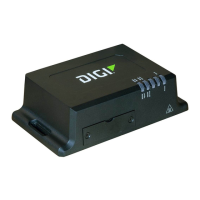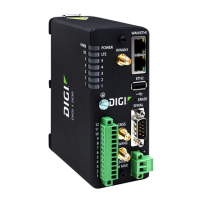Configure network interfaces Configure serial interfaces
Digi TransPort WR Routers User Guide 278
Sync parameters
The most common form of serial communications currently is asynchronous. Synchronous serial
communications links are still in use, and TransPort routers can support these. HDLC is a
synchronous protocol still in use that you can use with TransPort routers. This section describes
how to configure the synchronous communications interfaces. To enable synchronous mode, a
protocol such as LAPB must be configured to use a synchronous port as its lower layer interface. On
certain models, an informational message will appear on the web page which states that jumper
settings may need to be changed in order to support synchronous serial operation.
Note The number of synchronous serial ports available varies depending on the model and any
optional modules fitted.
Description
A description of the interface, if one is required.
Clock source Internal / External
Select between internal or external clock sources for the interface.
Mode
The specific serial protocol to use. Which buttons appear depend upon the capabilities of the
interface. The options available are; V.35, EIA530, RS232, EIA530A, RS449, and X.21.
Invert RX clock
When enabled, causes the router to invert the voltage level of the receive clock signal.
Invert TX clock
When enabled, causes the router to invert the voltage level of the transmit clock signal.
Encoding NRZ / NRZI
Select between non-return to zero (NRZ) and non-return to zero (inverted) (NRZI) signal
encodings.
Related CLI commands
Entity Instance Parameter Values Equivalent web parameter
sy 0 descr Text description of
interface
Description
sy 0 clksrc int,ext Clock source
sy 0 rxclkinv off, on Invert RX clock
sy 0 txclkinv off, on Invert TX clock
sy 0 encode nrz,nrzi Encoding

